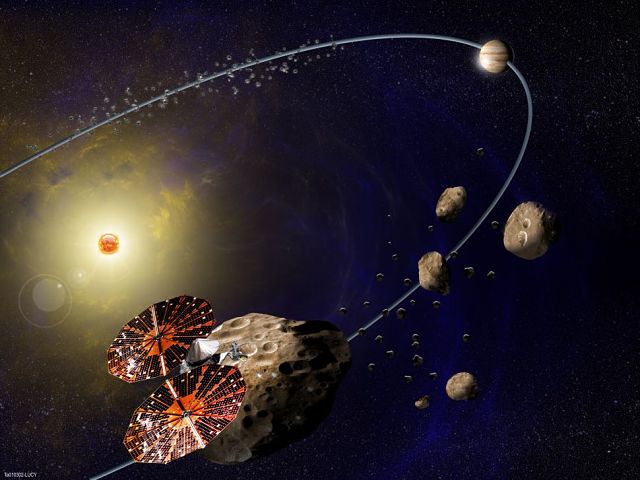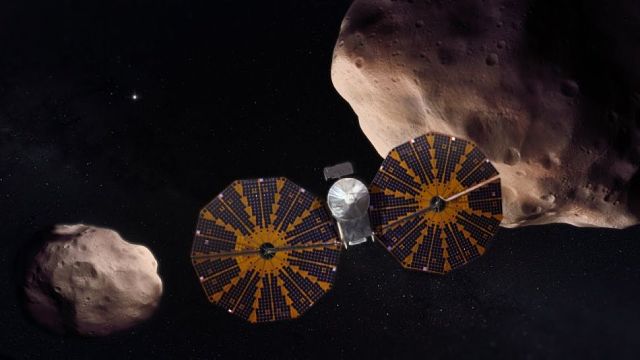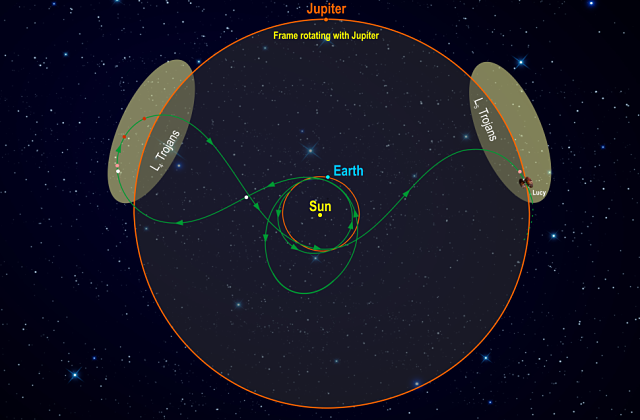 Lucy is named for the famous two-million-year-old fossil found in Ethiopia in the 1970s that, as a relative of modern humans, helped illuminate the evolution of our species. It is hoped that the spacecraft Lucy will similarly elucidate our solar system's earliest days. (Photo: An artist's concept of NASA's Lucy mission, which will study Jupiter's Trojan asteroids/Image credit: Southwest Research Institute)
Lucy is named for the famous two-million-year-old fossil found in Ethiopia in the 1970s that, as a relative of modern humans, helped illuminate the evolution of our species. It is hoped that the spacecraft Lucy will similarly elucidate our solar system's earliest days. (Photo: An artist's concept of NASA's Lucy mission, which will study Jupiter's Trojan asteroids/Image credit: Southwest Research Institute)
Space.com
Lucy mission: NASA’s visit to the Trojan asteroids
The Lucy mission is a NASA probe scheduled to launch in October 2021 that will explore a set of asteroids near Jupiter known as the Trojans. These ancient space rocks hold important clues to the creation of our solar system and, potentially, the origin of life on Earth.
Along with a mission called Psyche, Lucy was approved in January 2017 as part of NASA’s Discovery program, which supports focused and relatively cheap planetary missions whose development costs are capped at around $450 million. A year after approval, the mission was officially given a schedule and a set of eight asteroid targets.
Lucy is named for a famous female Australopithecus afarensis fossil found in Ethiopia that, as a relative of modern humans, helped illuminate the evolution of our species. It is hoped that the spacecraft Lucy will similarly elucidate our solar system’s earliest days.
LUCY SPACECRAFT SIZE AND INSTRUMENTS
Lucy spans more than 46 feet (14 meters) from tip to tip, larger than a 4-story building, though much of that width will be the enormous solar panels used to power the spacecraft, according to NASA. The spacecraft will carry an instrument that can measure the surface temperatures of its target asteroids, providing information about their composition, two high-resolution cameras, and a device that uses infrared light to inspect and identify ice, organic material, and different minerals in each asteroid.
NASA is scheduled to launch Lucy on its 12-year mission in October 2021 on an Atlas V 401 rocket from Cape Canaveral in Florida, according to the agency. The total cost to launch the spacecraft is approximately $148.3 million, which includes the launch service and other mission related costs.

An artist’s depiction of the Lucy spacecraft with extended solar panels, studying asteroids. (Image credit: SwRI)
LUCY MISSION TARGETS: THE TROJAN ASTEROIDS
The probe’s main objects of study are the Trojan asteroids. These objects are thought to be remnants from the primordial disk that formed the sun and planets, which were captured by Jupiter’s gravity sometime near the beginning of the solar system.
Lucy will be the first mission to visit the Trojans, which are each named for famous figures from the Trojan war in Greek mythology.
According to NASA, the Trojans share Jupiter’s orbit around the sun in two loose groups, with one set slightly ahead of the gas giant and another behind it. “The Trojans are stabilized by the sun and its largest planet in a gravitational balancing act,” the agency wrote.
After being launched from Earth, the spacecraft will first make a quick flyby of a main belt asteroid in 2025. The small space rock is named 52246 Donaldjohanson after the paleontologist who discovered the fossil Lucy. Situated between Mars and Jupiter, the fly-by will serve primarily as a test for the spacecraft’s instruments, according to the Southwest Research Institute (SwRI), which helps oversee the craft.

A diagram of Lucy’s itinerary among the Trojan asteroids that trail and lead Jupiter. (Image credit: Southwest Research Institute)
If all goes according to plan, between 2027 and 2033, Lucy will then fly past six Trojan asteroids, including three different asteroid subclasses and two objects that rotate around each other. NASA has said that “no other space mission in history has been launched to as many different destinations in independent orbits around our sun.”
The mission’s targets include C-type, D-type, and P-type asteroids, each of which will help scientists better understand the solar system’s genesis, according to SwRI.
WHAT ARE C-TYPE ASTEROIDS?
Lucy will fly by two C-type asteroids: the previously mentioned main asteroid belt object Donaldjohanson and a Trojan named Eurybates.
C-type asteroids are rich in carbon and are where most meteorites on Earth originated. The OSIRIS-REx and Hayabusa 2 missions have previously collected samples from C-type asteroids to bring back to our planet for study.
WHAT ARE D-TYPE AND P-TYPE ASTEROIDS?
It will also inspect two D-type asteroids, which are named Leucus and Orus, and three P-type asteroids, one named Polymele and a binary asteroid pair orbiting one another called Patroclus and Menoetius.
D-type and P-type asteroids are much redder than C-type asteroids and are hypothesized to be rich in organic and volatile elements. No mission has ever flown past a D- or P-type asteroid before.
The asteroids are expected to provide a wealth of information, especially about the organic material that would have rained down on our planet in its earliest days and potentially helped trigger the creation of living organisms. Each target is also thought to contain water ice underneath its rocky surface.
The final encounter with Patroclus and Menoetius is considered particularly special because the pair spend most of their time orbiting high above the main ecliptic plane of the solar system and are therefore hard to reach. The elusive asteroid pair will be passing through a region that is accessible to Lucy in March of 2033, when the spacecraft is scheduled to reach them.
—
Join the conversation on Twitter and Facebook.

























